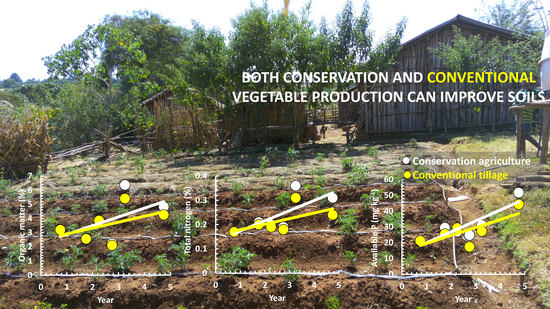Conservation and Conventional Vegetable Cultivation Increase Soil Organic Matter and Nutrients in the Ethiopian Highlands
Abstract
:1. Introduction
2. Materials and Methods
2.1. Site Description
2.2. Experimental Design and Layout
2.3. Soil Sampling and Analysis
2.4. Data Analysis
3. Results
3.1. Initial Soil Characteristics
3.2. Effects of CA on Soil Characteristics after Three and Four Years
3.2.1. Organic Matter (OM)
3.2.2. Total Soil Nitrogen (TN)
3.2.3. Available Phosphorus (P)
4. Discussion
Bottlenecks to the Implementation of Conservation Agriculture
5. Conclusions
Author Contributions
Funding
Informed Consent Statement
Data Availability Statement
Acknowledgments
Conflicts of Interest
References
- Keesstra, S.; Mol, G.; de Leeuw, J.; Okx, J.; de Cleen, M.; Visser, S. Soil-related sustainable development goals: Four concepts to make land degradation neutrality and restoration work. Land 2018, 7, 133. [Google Scholar] [CrossRef] [Green Version]
- Giller, K.E.; Witter, E.; Corbeels, M.; Tittonell, P. Conservation agriculture and smallholder farming in Africa: The heretics’ view. Field Crops Res. 2009, 114, 23–34. [Google Scholar] [CrossRef]
- Assefa, T.; Jha, M.; Reyes, M.; Worqlul, A.; Doro, L.; Tilahun, S. Conservation agriculture with drip irrigation: Effects on soil quality and crop yield in sub-Saharan Africa. J. Soil Water Conserv. 2020, 75, 209–217. [Google Scholar] [CrossRef]
- Araya, T.; Cornelis, W.; Nyssen, J.; Govaerts, B.; Bauer, H.; Gebreegziabher, T.; Oicha, T.; Raes, D.; Sayre, K.D.; Haile, M. Effects of conservation agriculture on runoff, soil loss and crop yield under rainfed conditions in Tigray, Northern Ethiopia. Soil Use Manag. 2011, 27, 404–414. [Google Scholar] [CrossRef]
- Bationo, A.; Kihara, J.; Vanlauwe, B.; Waswa, B.; Kimetu, J. Soil organic carbon dynamics, functions and management in West African agro-ecosystems. Agric. Syst. 2007, 94, 13–25. [Google Scholar] [CrossRef] [Green Version]
- Tebebu, T.Y.; Bayabil, H.K.; Stoof, C.R.; Giri, S.K.; Gessess, A.A.; Tilahun, S.A.; Steenhuis, T.S. Characterization of degraded soils in the humid Ethiopian Highlands. Land Degrad. Dev. 2016, 28, 1891–1901. [Google Scholar] [CrossRef] [Green Version]
- Nyssen, J.; Vandenreyken, H.; Poesen, J.; Moeyersons, J.; Deckers, J.; Haile, M.; Salles, C.; Govers, G. Rainfall erosivity and variability in the Northern Ethiopian Highlands. J. Hydrol. 2005, 311, 172–187. [Google Scholar] [CrossRef]
- Berakhi, O.; Brancaccio, L.; Calderoni, G.; Coltorti, M.; Dramis, F.; Umer, M.M. The Mai Maikden sedimentary sequence: A reference point for the environmental evolution of the Highlands of Northern Ethiopia. Geomorphology 1998, 23, 127–138. [Google Scholar] [CrossRef]
- Gebre-Selassie, A.; Bekele, T. A Review of Ethiopian Agriculture: Roles, Policy and small-Scale Farming Systems; Oxfam International: Oxford, UK, 2012; pp. 36–65. [Google Scholar]
- Solomon, D.; Fritzsche, F.; Lehmann, J.; Tekalign, M.; Zech, W. Soil organic matter dynamics in the subhumid agroecosystems of the Ethiopian Highlands: Evidence from natural 13C abundance and particle-size fractionation. Soil Sci. Soc. Am. J. 2002, 66, 969–978. [Google Scholar] [CrossRef] [Green Version]
- Richardson, A.E.; Simpson, R. Soil microorganisms mediating phosphorus availability update on microbial phosphorus. Plant Physiol. 2011, 156, 989–996. [Google Scholar] [CrossRef] [Green Version]
- Limon-Ortega, A.; Sayre, K.D.; Francis, C.A. Wheat nitrogen use efficiency in a bed planting system in Northwest Mexico. Agron. J. 2000, 92, 303–308. [Google Scholar] [CrossRef]
- Belay, S.A.; Assefa, T.T.; Prasad, P.; Schmitter, P.; Worqlul, A.W.; Steenhuis, T.S.; Reyes, M.R.; Tilahun, S.A. The Response of Water and Nutrient Dynamics and of Crop Yield to Conservation Agriculture in the Ethiopian Highlands. Sustainability 2020, 12, 5989. [Google Scholar] [CrossRef]
- Nyborg, M.; Solberg, E.; Izaurralde, R.; Malhi, S.; Molina-Ayala, M. Influence of long-term tillage, straw and N fertilizer on barley yield, plant-N uptake and soil-N balance. Soil Tillage Res. 1995, 36, 165–174. [Google Scholar] [CrossRef]
- Giller, K.E.; Corbeels, M.; Nyamangara, J.; Triomphe, B.; Affholder, F.; Scopel, E.; Tittonell, P. A research agenda to explore the role of conservation agriculture in African smallholder farming systems. Field Crops Res. 2011, 124, 468–472. [Google Scholar] [CrossRef] [Green Version]
- Lanckriet, S.; Araya, T.; Cornelis, W.; Verfaillie, E.; Poesen, J.; Govaerts, B.; Bauer, H.; Deckers, J.; Haile, M.; Nyssen, J. Impact of conservation agriculture on catchment runoff and soil loss under changing climate conditions in May Zeg-zeg (Ethiopia). J. Hydrol. 2012, 475, 336–349. [Google Scholar] [CrossRef] [Green Version]
- Vanlauwe, B.; Wendt, J.; Giller, K.E.; Corbeels, M.; Gerard, B.; Nolte, C. A fourth principle is required to define conservation agriculture in sub-Saharan Africa: The appropriate use of fertilizer to enhance crop productivity. Field Crops Res. 2014, 155, 10–13. [Google Scholar] [CrossRef]
- Erenstein, O. Smallholder conservation farming in the tropics and sub-tropics: A guide to the development and dissemination of mulching with crop residues and cover crops. Agric. Ecosyst. Environ. 2003, 100, 17–37. [Google Scholar] [CrossRef]
- Belay, S.A.; Schmitter, P.; Worqlul, A.W.; Steenhuis, T.S.; Reyes, M.R.; Tilahun, S.A. Conservation Agriculture Saves Irrigation Water in the Dry Monsoon Phase in the Ethiopian Highlands. Water 2019, 11, 2103. [Google Scholar] [CrossRef] [Green Version]
- Assefa, T.; Jha, M.; Reyes, M.; Tilahun, S.; Worqlul, A.W. Experimental Evaluation of Conservation Agriculture with Drip Irrigation for Water Productivity in Sub-Saharan Africa. Water 2019, 11, 530. [Google Scholar] [CrossRef] [Green Version]
- Yimam, A.Y.; Assefa, T.T.; Adane, N.F.; Tilahun, S.A.; Jha, M.K.; Reyes, M.R. Experimental Evaluation for the Impacts of Conservation Agriculture with Drip Irrigation on Crop Coefficient and Soil Properties in the Sub-Humid Ethiopian Highlands. Water 2020, 12, 947. [Google Scholar] [CrossRef] [Green Version]
- Abidela, H.M.; Muche, H.; Schmitter, P.; Nakawuka, P.; Tilahun, S.A.; Langan, S.; Barron, J.; Steenhuis, T.S. Deep tillage improves degraded soils in the (sub) humid Ethiopian Highlands. Land 2019, 8, 159. [Google Scholar] [CrossRef] [Green Version]
- Fenta, H.M.; Hussein, M.A.; Tilahun, S.A.; Nakawuka, P.; Steenhuis, T.S.; Barron, J.; Adie, A.; Blummel, M.; Schmitter, P. Berken plow and intercropping with pigeon pea ameliorate degraded soils with a hardpan in the Ethiopian Highlands. Geoderma 2022, 407, 115523. [Google Scholar] [CrossRef]
- Juo, A. Selected Methods for Soil and Plant Analysis, 2nd ed.; International Institute of Tropical Agriculture: Ibadan, Nigeria, 1978. [Google Scholar]
- Sertsu, S.; Bekele, T. Procedures for Soil and Plant Analysis; National Soil Research Organization: Technical Paper No. 74; Ethiopian Agricultural Research Organization: Addis Ababa, Ethiopia, 2000; p. 110. [Google Scholar]
- Walkley, A.; Black, I.A. An examination of the Degtjareff method for determining soil organic matter, and a proposed modification of the chromic acid titration method. Soil Sci. 1934, 37, 29–38. [Google Scholar] [CrossRef]
- Bray, R.H.; Kurtz, L. Determination of total, organic, and available forms of phosphorus in soils. Soil Sci. 1945, 59, 39–46. [Google Scholar] [CrossRef]
- Macdonald, G.; Peck, N.; Vittum, M.J. Relationship between ammonium acetate-acetic acid and Morgan’s solution for determining extractable P, K, Ca, and Mg in soils derived from calcareous glacial till. Commun. Soil Sci. Plant Anal. 1978, 9, 717–728. [Google Scholar] [CrossRef]
- Rengel, Z.; Robinson, D. Determination of cation exchange capacity of ryegrass roots by summing exchangeable cations. Plant Soil 1989, 116, 217–222. [Google Scholar] [CrossRef]
- Cassel, D.; Nielsen, D.J.; Methods, M. Field capacity and available water capacity. Phys. Mineral. Methods 1986, 5, 901–926. [Google Scholar]
- Bryhn, A.C.; Dimberg, P.H. An operational definition of a statistically meaningful trend. PLoS ONE 2011, 6, e19241. [Google Scholar] [CrossRef] [Green Version]
- Redel, Y.D.; Rubio, R.; Rouanet, J.L.; Borie, F. Phosphorus bioavailability affected by tillage and crop rotation on a Chilean volcanic derived Ultisol. Geoderma 2007, 139, 388–396. [Google Scholar] [CrossRef]
- Shi, P.; Schulin, R. Erosion-induced losses of carbon, nitrogen, phosphorus and heavy metals from agricultural soils of contrasting organic matter management. Sci. Total Environ. 2018, 618, 210–218. [Google Scholar] [CrossRef]
- Malecka, I.; Blecharczyk, A.; Sawinska, Z.; Dobrzeniecki, T. The effect of various long-term tillage systems on soil properties and spring barley yield. Turk. J. Agric. For. 2012, 36, 217–226. [Google Scholar]
- Poudel, D.D.; Horwath, W.R.; Mitchell, J.P.; Temple, S.R. Impacts of cropping systems on soil nitrogen storage and loss. Agric. Syst. 2001, 68, 253–268. [Google Scholar] [CrossRef]
- Busari, M.A.; Kukal, S.S.; Kaur, A.; Bhatt, R.; Dulazi, A.A. Conservation tillage impacts on soil, crop and the environment. Int. Soil Water Conserv. Res. 2015, 3, 119–129. [Google Scholar] [CrossRef] [Green Version]
- Metay, A.; Moreira, J.A.A.; Bernoux, M.; Boyer, T.; Douzet, J.M.; Feigl, B.; Feller, C.; Maraux, F.; Oliver, R.; Scopel, E. Storage and forms of organic carbon in a no-tillage under cover crops system on clayey Oxisol in dryland rice production (Cerrados, Brazil). Soil Tillage Res. 2007, 94, 122–132. [Google Scholar] [CrossRef]
- Sisti, C.P.; dos Santos, H.P.; Kohhann, R.; Alves, B.J.; Urquiaga, S.; Boddey, R.M. Change in carbon and nitrogen stocks in soil under 13 years of conventional or zero tillage in southern Brazil. Soil Tillage Res. 2004, 76, 39–58. [Google Scholar] [CrossRef]
- Novara, A.; Pulido, M.; Rodrigo-Comino, J.; Di Prima, S.; Smith, P.; Gristina, L.; Keesstra, S. Long-term organic farming on a citrus plantation results in soil organic matter recovery. Cuad. Investig. Geogr. 2019, 45, 271–286. [Google Scholar] [CrossRef] [Green Version]
- Amare, S.; Keesstra, S.; van der Ploeg, M.; Langendoen, E.; Steenhuis, T.S.; Tilahun, S. Causes and Controlling Factors of Valley Bottom Gullies. Land 2019, 8, 141. [Google Scholar] [CrossRef] [Green Version]
- Yibeltal, M.; Tsunekawa, A.; Haregeweyn, N.; Adgo, E.; Meshesha, D.T.; Masunaga, T.; Tsubo, M.; Billi, P.; Ebabu, K.; Fenta, A.A.; et al. Morphological characteristics and topographic thresholds of gullies in different agro-ecological environments. Geomorphology 2019, 341, 15–27. [Google Scholar] [CrossRef]
- Ayele, G.K.; Gessess, A.A.; Addisie, M.B.; Tilahun, S.A.; Tebebu, T.Y.; Tenessa, D.B.; Langendoen, E.J.; Nicholson, C.F.; Steenhuis, T.S. A Biophysical and Economic Assessment of a Community-based Rehabilitated Gully in the Ethiopian Highlands. Land Degrad. Dev. 2016, 27, 270–280. [Google Scholar] [CrossRef]
- Ayele, G.K.; Addisie, M.B.; Langendoen, E.J.; Tegegne, N.H.; Tilahun, S.A.; Moges, M.A.; Nicholson, C.F.; Steenhuis, T.S. Evaluating erosion control practices in an actively gullying Watershed in the highlands of Ethiopia. Earth Surf. Process. Landf. 2018, 43, 2835–2843. [Google Scholar] [CrossRef]
- Ayele, G.K.; Gessess, A.A.; Addisie, M.B.; Tilahun, S.A.; Tenessa, D.B.; Langendoen, E.J.; Steenhuis, T.S.; Nicholson, C.F. The economic cost of upland and gully erosion on subsistence agriculture for a watershed in the Ethiopian Highlands. Afr. J. Agric. Resour. Econ. 2015, 10, 265–278. [Google Scholar]
- Addisie, M.B.; Langendoen, E.J.; Aynalem, D.W.; Ayele, G.K.; Tilahun, S.A.; Schmitter, P.; Mekuria, W.; Moges, M.M.; Steenhuis, T.S. Assessment of practices for controlling shallow valley-bottom gullies in the sub-Humid Ethiopian Highlands. Water 2018, 10, 389. [Google Scholar] [CrossRef] [Green Version]
- Yibeltal, M.; Tsunekawa, A.; Haregeweyn, N.; Adgo, E.; Meshesha, D.T.; Masunaga, T.; Tsubo, M.; Billi, P.; Ebabu, K.; Berihun, M.L. Effect of subsurface water level on gully headcut retreat in tropical Highlands of Ethiopia. Earth Surf. Process. Landf. 2021, 46, 1209–1222. [Google Scholar] [CrossRef]
- Sosina, B.; Holden, S. Are Rural Youth in Ethiopia Abandoning Agriculture? World Dev. 2014, 64, 259–272. [Google Scholar] [CrossRef] [Green Version]
- Duguma, L.A.; Minang, P.A.; Freeman, O.E.; Hager, H. System wide impacts of fuel usage patterns in the Ethiopian Highlands: Potentials for breaking the negative reinforcing feedback cycles. Energy Sustain. Dev. 2014, 20, 77–85. [Google Scholar] [CrossRef]
- Rossiter, J.; Minale, M.W.; Andarge, W.; Twomlow, S. A communities Eden–grazing Exclosure success in Ethiopia. Int. J. Agric. Sustain. 2017, 15, 514–526. [Google Scholar] [CrossRef]
- Haregeweyn, N.; Berhe, A.; Tsunekawa, A.; Tsubo, M.; Meshesha, D.T. Integrated Watershed Management as an Effective Approach to Curb Land Degradation: A Case Study of the Enabered Watershed in Northern Ethiopia. Environ. Manag. 2021, 50, 1219–1233. [Google Scholar] [CrossRef]
- El-Shater, T.; Yigezu, Y.A. Can Retention of Crop Residues on the Field Be Justified on Socioeconomic Grounds? A Case Study from the Mixed Crop-Livestock Production Systems of the Moroccan Drylands. Agronomy 2021, 11, 1465. [Google Scholar] [CrossRef]
- Nigussie, Z.; Tsunekawa, A.; Haregeweyn, N.; Tsubo, M.; Adgo, E.; Ayalew, Z.; Abele, S. Small-Scale Woodlot Growers’ Interest in Participating in Bioenergy Market in Rural Ethiopia. Environ. Manag. 2021, 68, 553–565. [Google Scholar] [CrossRef]
- Enku, T.; Melesse, A.M.; Ayana, E.K.; Tilahun, S.A.; Abate, M.; Steenhuis, T.S. Groundwater use of a small Eucalyptus patch during the dry monsoon phase. Biologia 2020, 75, 853–864. [Google Scholar] [CrossRef]
- Alemayehu, A.; Tamado, T.; Nigussie, D.; Yigzaw, D.; Kinde, T.; Wortmann, C. Maize–common bean intercropping to optimize maize-based crop production. J. Agric. Sci. 2017, 155, 1124–1136. [Google Scholar] [CrossRef]
- Jaleta, M.; Marenya, P.; Beshir, B.; Erenstein, O. Does crop diversification reduce downside risk of external maize yield-enhancing technology? Evidence from Ethiopia. Afr. J. Agric. Resour. Econ. 2020, 15, 95–110. [Google Scholar] [CrossRef]
- Preissel, S.; Reckling, M.; Schläfke, N.; Zander, P. Magnitude and farm-economic value of grain legume pre-crop benefits in Europe: A review. Field Crops Res. 2015, 175, 64–79. [Google Scholar] [CrossRef] [Green Version]
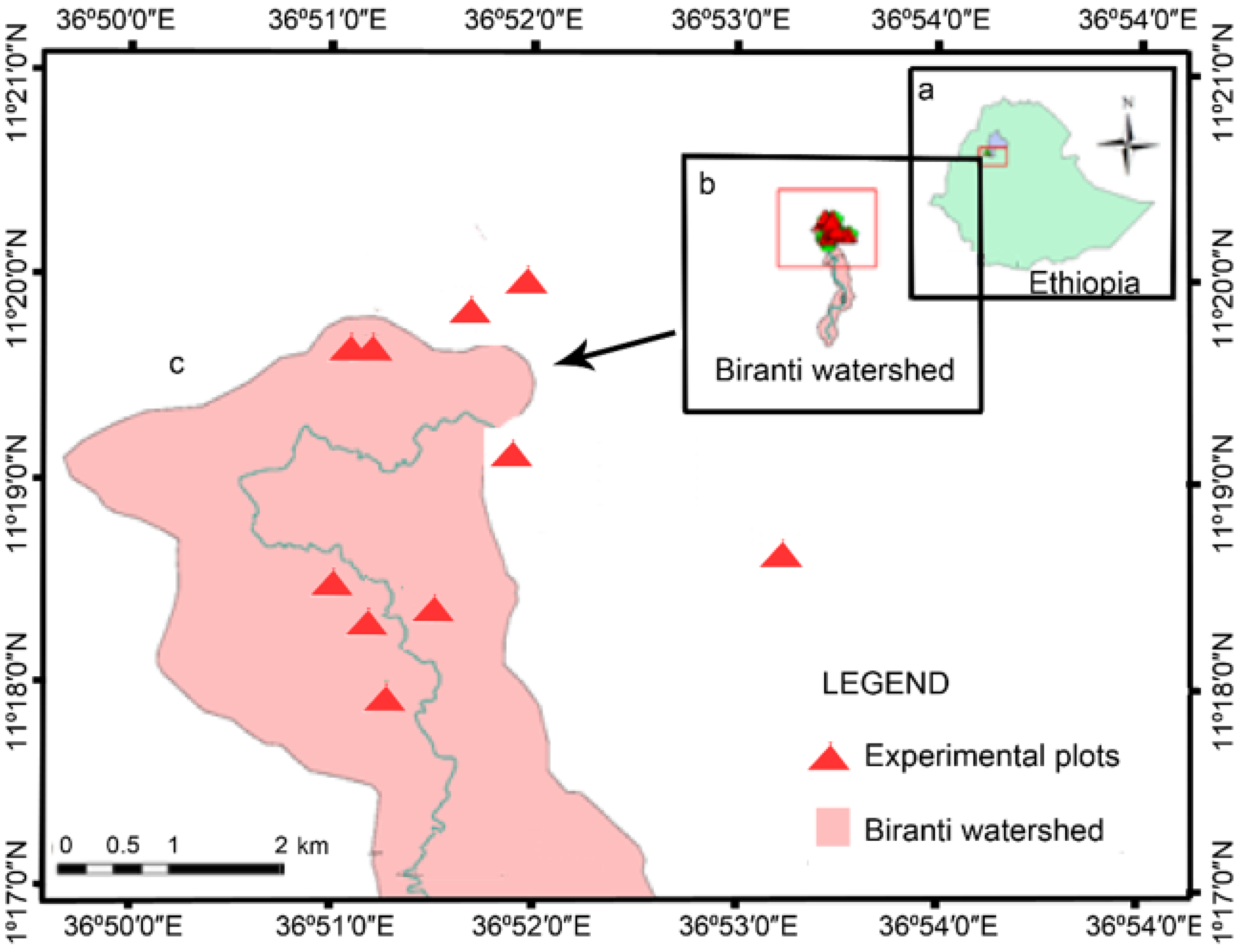
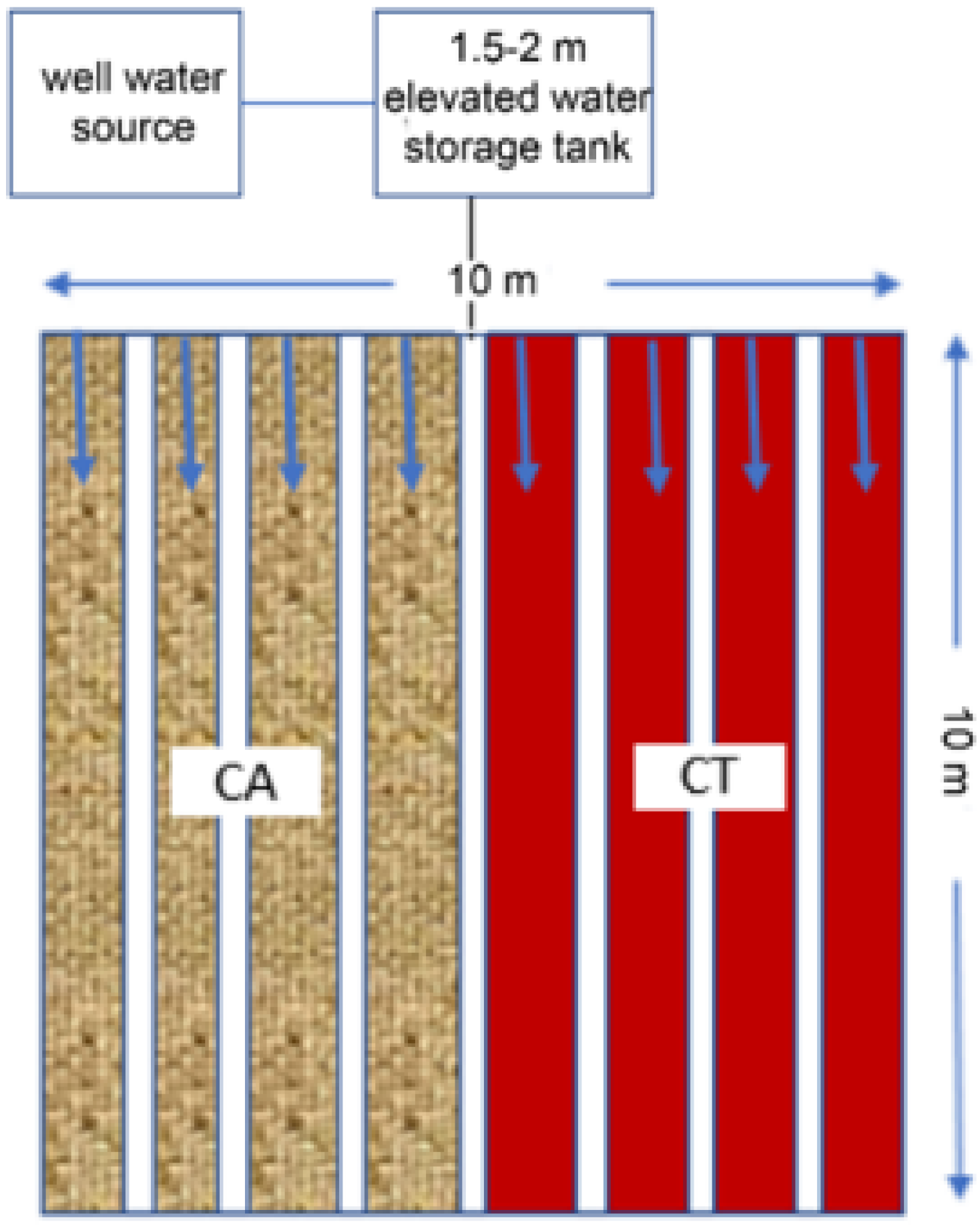

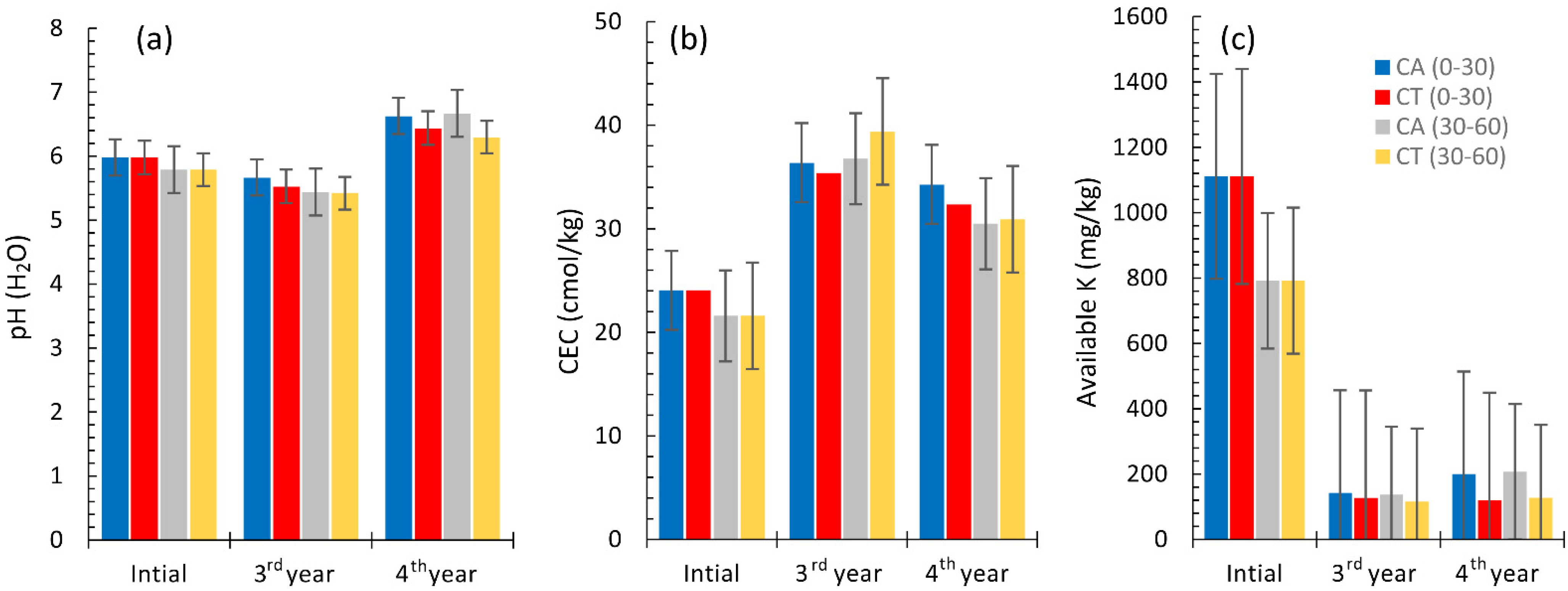
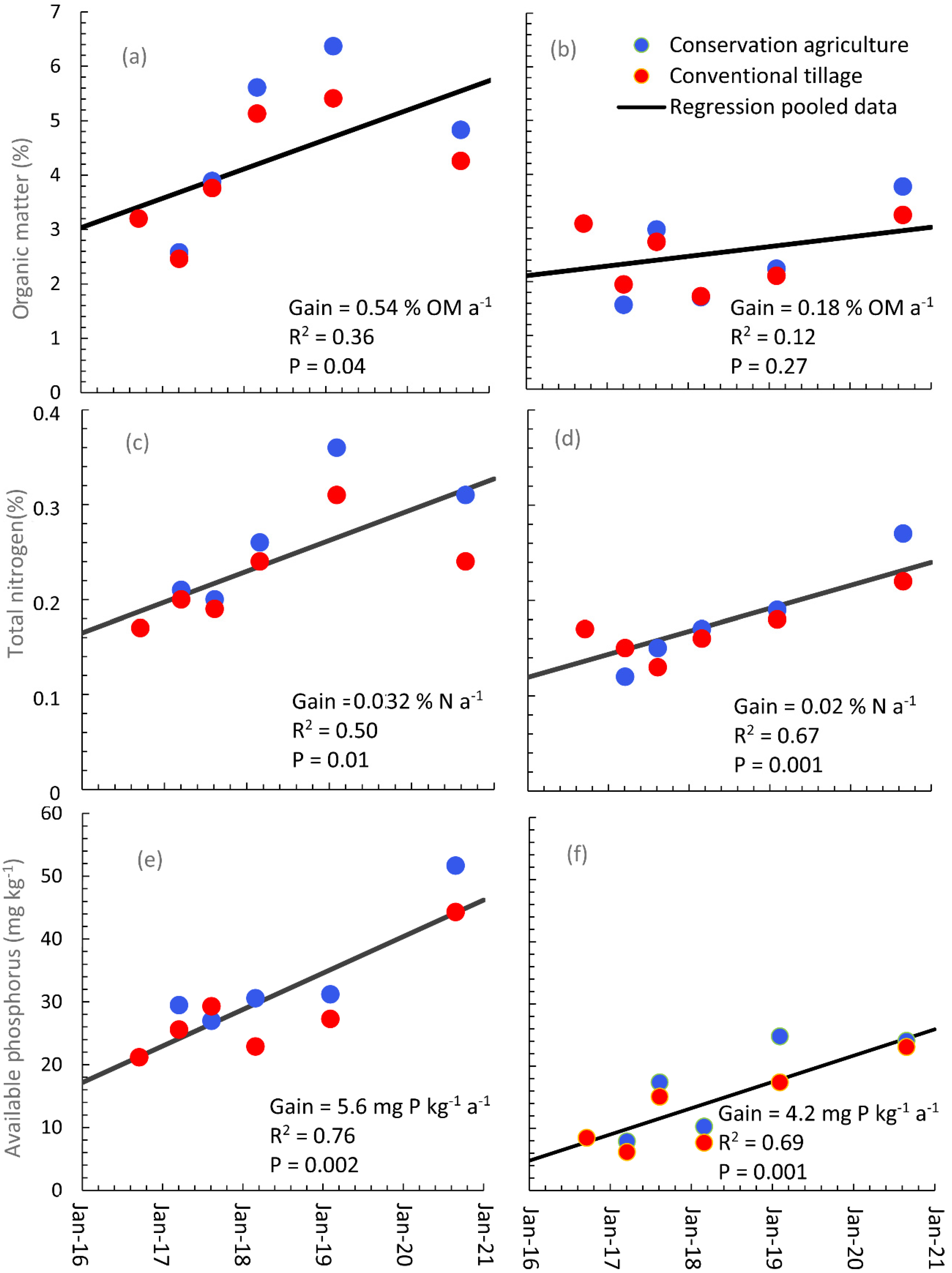
| Crop * (Year) | Tillage | Transplanting | Fertilizer Application | Mulch Application | Harvesting | Soil Sampling | Manure Application | |
|---|---|---|---|---|---|---|---|---|
| Onion (2016/2017) | Date | 9/25/2016–3/30/2016 | 12/20/2016 | 12/25/2016 | 01/05/2017 | 3/22/2018 | 3/25/2017 | 3/25/2017 |
| Amount (kg ha−1) | - | - | 200 | 4000 | - | - | 5000 | |
| Pepper (2017) | Date | 2/20/2017–4/25/2017 | 05/01/2017 | - | 05/01/2017 | 7/10/2017–8/10/2017 | 08/10/2017 | |
| Amount (kg ha−1) | - | - | 4000 | - | - | |||
| Garlic (2017/2018) | Date | 10/18/2017 | 10/27/2017 | 10/27/2017 | 15/27/2017 | 2/26/2018 | 2/26/2018 | 2/27/2018 |
| Amount (kg ha−1) | - | - | 200 | 4000 | - | - | 5000 | |
| Pepper (2018) | Date | 2/15/2018 | 3/13/2018 | 03/12/2018 | 07/05/2018 | 6/1/2018–8/25/2018 | 8/25/2018 | |
| Amount (kg ha−1) | - | - | 100 | 4000 | - | - | ||
| Onion (2018/2019) | Date | 10/15/2018 | 10/27/2018 | 10/27/2018 | 11/05/2018 | 02/02/2019 | 02/02/2019 | 02/05/2019 |
| Amount (kg ha−1) | - | - | 200 | 4000 | - | - | 5000 | |
| Pepper (2019) | Date | 2/15/2019 | 3/02/2019 | 3/02/2019 | 7/15/2019 | 6/20/2019 | - | - |
| Amount (kg ha−1) | - | - | 200 | 4000 | - | - | 5000 | |
| Onion (2019/2020) | Date | 02/15/2019 | 03/11/2019 | 03/11/2019 | 07/15/2019 | 6/20/2019 | - | - |
| Amount (kg ha−1) | - | - | 200 | 4000 | - | - | 5000 | |
| Pepper (2020) | Date | 2/15-25/2020 | 3/25/2020 | 6/30/20 | 04/05/2020 | 6/15/2020–8/25/2020 | 8/25/2020 | - |
| Amount (kg ha−1) | - | - | 100 | 4000 | - | - |
| Vegetable | Year (Dry Irrigated or Rainfed) | Irrigation Water Added (mm /Growing Season) | Vegetable Fresh Yield (Mg ha−1) | ||
|---|---|---|---|---|---|
| CA | CT | CA | CT | ||
| Onion | 2016/2017 (dry) | 520 | 520 | 24.3 | 17.9 |
| Pepper | 2017 (wet) | 50 | 50 | 5.1 | 5.5 |
| Garlic | 2017/2018 (dry) | 260 | 309 | 5.3 | 3.8 |
| Pepper | 2018 (wet) | 367 | 475 | 11.7 | 9.1 |
| Onion | 2018/2019 (dry) | 408 | 479 | 10.2 | 8.5 |
| Pepper | 2019 | 255 | 288 | 6.3 | 5.9 |
| Pepper | 2020 (wet) | 289 | 355 | 12.3 | 9.8 |
| Soil Characteristics | Soil Depth | Soil Depth |
|---|---|---|
| 0–30 cm | 30–60 cm | |
| Bulk density (g cc−1) | 1.14 ± 0.10 | 1.22 ± 0.13 |
| pH (H2O, 1:2.5) | 6.0 ± 0.64 | 5.8 ± 0.63 |
| Electrical conductivity (EC) (dS m−1) | 1.13 ± 0.12 | 0.09 ± 0.05 |
| Cation exchange capacity (CEC) (meq kg−1) | 24.0 ± 4.0 | 25.3 ± 4.5 |
| Available potassium (g kg−1) | 1.11 ± 0.57 | 0.79 ± 0.54 |
| Available phosphorus (mg kg−1) | 21.2 ± 12.3 | 8.5 ± 4.8 |
| Total nitrogen (%) | 0.17 ± 0.05 | 0.17 ± 0.06 |
| Organic matter (%) | 3.18 ± 0.91 | 3.08 ± 1.06 |
| Organic carbon (%) | 1.84 ± 0.53 | 1.79 ± 0.62 |
| Field capacity (%) | 31.4 ± 3.9 | 28.8 ± 2.8 |
| Permanent wilting point (%) | 22.2 ± 3.6 | 21.6 ± 1.93 |
| Bulk density (g cm−3) | 1.25 ± 0.8 | 1.32 ± 1.1 |
| Sand (%) | 39 ± 17 | 22 ± 10 |
| Silt (%) | 27 ± 5 | 25 ± 4 |
| Clay (%) | 35 ± 17 | 54 ± 14 |
| Vegetable | Year (Phase) | 0–30 cm | 30–60 cm | ||
|---|---|---|---|---|---|
| CA | CT | CA | CT | ||
| Organic Matter Content (%) | |||||
| 2016 (initial) | 3.2 ± 0.9 | 3.2 ± 0.9 | 3.1 ± 1.1 | 3.1 ± 1.1 | |
| Pepper | 2017 (wet) | 2.6 ± 0.8 | 2.5 ± 0.7 | 1.6 ± 0.3 | 1.9 ± 0.6 |
| Garlic | 2017/2018 (dry) | 3.9 ± 1.3 | 3.8 ± 1.0 | 3.0 ± 1.1 | 2.7 ± 0.5 |
| Pepper | 2018 (wet) | 5.6 ± 3.0 | 5.1 ± 0.9 | 1.7±0.6 | 1.7 ± 0.6 |
| Onion | 2018/2019 (dry) | 6.4 ± 2.93 | 5.4± 3.0 | 2.2 ± 1.8 | 2.1 ± 0.9 |
| Pepper | 2020 (wet) | 4.8 ± 0.09 | 4.3 ± 0.6 | 3.8± 0.8 | 3.2 ± 0.7 |
| Mean | 4.4 ± 1.2 | 4.0 ± 1.21 | 2.7 ± 0.90 | 2.5 ± 0.99 | |
| Four-year change (%) * | 50 | 33 | 22 | 5 | |
| Total Nitrogen (%) | |||||
| 2016 (initial) | 0.17 ± 0.05 | 0.17 ± 0.05 | 0.17 ± 0.06 | 0.17 ± 0.06 | |
| Pepper | 2017 (wet) | 0.21 ± 0.06 | 0.20 ± 0.05 | 0.12 ± 0.03 | 0.15 ± 0.04 |
| Garlic | 2017/2018 (dry) | 0.20 ± 0.06 | 0.19 ± 0.05 | 0.15 ± 0.05 | 0.13 ± 0.02 |
| Pepper | 2018 (wet) | 0.26 ± 0.10 | 0.24 ± 0.14 | 0.17 ±0.03 | 0.16 ± 0.05 |
| Onion | 2018/2019 (dry) | 0.36 ± 0.16 | 0.31 ± 0.14 | 0.19 ± 0.07 | 0.18 ± 0.08 |
| Pepper | 2020 (wet) | 0.31 ± 0.03 | 0.24 ± 0.06 | 0.27 ± 0.04 | 0.22 ± 0.04 |
| Mean | 0.26 ± 0.08 | 0.23 ± 0.08 | 0.18 ± 0.05 | 0.17 ± 0.06 | |
| Four-year change (%) * | 82 | 41 | 59 | 29 | |
| Available Phosphorus (mg kg−1) | |||||
| 2016 (initial) | 21 ± 12 | 21 ± 12 | 8.5 ± 4.7 | 8.5 ± 4.7 | |
| Pepper | 2017 (wet) | 29 ± 38 | 26 ± 26 | 7.9 ± 10 | 6.2 ± 3.9 |
| Garlic | 2017/2018 (dry) | 27 ± 17 | 29 ± 18 | 17 ± 16 | 15 ± 11 |
| Pepper | 2018 (wet) | 31 ± 31 | 23 ± 21 | 10 ± 10 | 7.7 ± 5 |
| Onion | 2018/2019 (dry) | 31 ± 25 | 27± 23 | 25 ± 18 | 17 ± 11 |
| Pepper | 2020 (wet) | 52 ± 25 | 44 ± 26 | 24 ± 14 | 23 ± 14 |
| Mean | 32 ± 25 | 28 ± 21 | 16 ±16.1 | 13 ± 11 | |
| Four-year change (%) * | 144 | 29 | 183 | 172 | |
Publisher’s Note: MDPI stays neutral with regard to jurisdictional claims in published maps and institutional affiliations. |
© 2022 by the authors. Licensee MDPI, Basel, Switzerland. This article is an open access article distributed under the terms and conditions of the Creative Commons Attribution (CC BY) license (https://creativecommons.org/licenses/by/4.0/).
Share and Cite
Belay, S.A.; Assefa, T.T.; Worqlul, A.W.; Steenhuis, T.S.; Schmitter, P.; Reyes, M.R.; Prasad, P.V.V.; Tilahun, S.A. Conservation and Conventional Vegetable Cultivation Increase Soil Organic Matter and Nutrients in the Ethiopian Highlands. Water 2022, 14, 476. https://doi.org/10.3390/w14030476
Belay SA, Assefa TT, Worqlul AW, Steenhuis TS, Schmitter P, Reyes MR, Prasad PVV, Tilahun SA. Conservation and Conventional Vegetable Cultivation Increase Soil Organic Matter and Nutrients in the Ethiopian Highlands. Water. 2022; 14(3):476. https://doi.org/10.3390/w14030476
Chicago/Turabian StyleBelay, Sisay A., Tewodros T. Assefa, Abeyou W. Worqlul, Tammo S. Steenhuis, Petra Schmitter, Manuel R. Reyes, P. V. Vara Prasad, and Seifu A. Tilahun. 2022. "Conservation and Conventional Vegetable Cultivation Increase Soil Organic Matter and Nutrients in the Ethiopian Highlands" Water 14, no. 3: 476. https://doi.org/10.3390/w14030476






